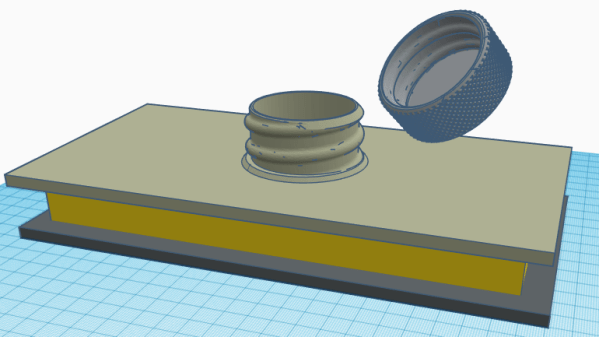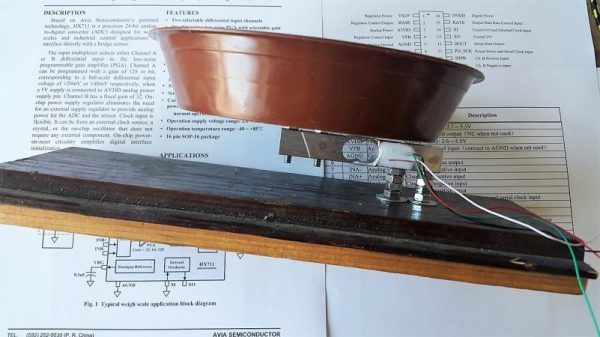We make no claims to be an expert on anything, but we do know that rule number one of working with big, expensive, mission-critical equipment is: Don’t break the big, expensive, mission-critical equipment. Unfortunately, though, that’s just what happened to the Deep Space Network’s 70-meter dish antenna at Goldstone, California. NASA announced the outage this week, but the accident that damaged the dish occurred much earlier, in mid-September. DSS-14, as the antenna is known, is a vital part of the Deep Space Network, which uses huge antennas at three sites (Goldstone, Madrid, and Canberra) to stay in touch with satellites and probes from the Moon to the edge of the solar system. The three sites are located roughly 120 degrees apart on the globe, which gives the network full coverage of the sky regardless of the local time.
urine13 Articles
Where There Is No Down: Measuring Liquid Levels In Space
As you can probably imagine, we get tips on a lot of really interesting projects here at Hackaday. Most are pretty serious, at least insofar as they aim to solve a specific problem in some new and clever way. Some, though, are a little more lighthearted, such as a fun project that came across the tips line back in May. Charmingly dubbed “pISSStream,” the project taps into NASA’s official public telemetry stream for the International Space Station to display the current level of the urine tank on the Space Station.
Now, there are a couple of reactions to a project like this when it comes across your desk. First and foremost is bemusement that someone would spend time and effort on a project like this — not that we don’t appreciate it; the icons alone are worth the price of admission. Next is sheer amazement that NASA provides access to a parameter like this in its public API, with a close second being the temptation to look at what other cool endpoints they expose.
But for my part, the first thing I thought of when I saw that project was, “How do they even measure liquid levels in space?” In a place where up and down don’t really have any practical meaning, the engineering challenges of liquid measurement must be pretty interesting. That led me down the rabbit hole of low-gravity process engineering, a field that takes everything you know about how fluids behave and flushes it into the space toilet.
Continue reading “Where There Is No Down: Measuring Liquid Levels In Space”
Using Forward- And Reverse-Osmosis To Let Astronaut EVA Suits Produce Fresh Water From Urine
An uncomfortable reality with the spacesuits used for extravehicular activities (EVA) – commonly referred to as spacewalks – is that the astronaut spends hours in them, during which normal bodily functions like urinating and defecating continue. The current EVA record at the ISS is currently a hair under nine hours, necessitating a new approach. A team of researchers have now pitched the idea of an in-suit water recovery system with an article by [Sofia Etlin] and colleagues as published in Frontiers in Space Technologies.
For the current Extravehicular Mobility Unit (EMU) EVA spacesuit the current solution is what is called the MAG: the Maximum Absorbency Garment, which is effectively a fancy adult diaper with sodium polyacrylate as absorbent for up to 2 L of fluids. It replaced the urine collection device (UCD) that was used until female astronauts joined the astronaut corps in the 1970s. Generally astronauts aim to not defecate until they finish their EVA, which leaves urinating and the related activity of rehydrating as the spacesuits only have 0.95 L of water that has to last the duration of the spacewalk. Continue reading “Using Forward- And Reverse-Osmosis To Let Astronaut EVA Suits Produce Fresh Water From Urine”
Urine Flow Measurement Made Accessible With UroFlow
If you’re dealing with a chronic illness, the ability to continuously monitor your symptoms is indispensable, helping you gain valuable insights into what makes your body tick – or, rather, mis-tick. However, for many illnesses, you need specialized equipment to monitor them, and it tends to be that you can only visit your doctor every so often. Thankfully, we hackers can figure out ways to monitor our conditions on our own. With a condition called BPH (Benign Prostate Hyperplasia), one of the ways to monitor it is taking measurements of urinary flow rate. Being able to take these measurements at home provides better insights, and, having found flow rate measurement devices to be prohibitively expensive to even rent, [Jerry Smith] set out to build his own.
This build is truly designed to be reproducible for anyone who needs such a device. Jerry has intricately documented the project and its inner workings – the 31-page document contains full build instructions, BOM for ordering, PCB description and pinout diagrams, calibration and validation instructions, and even software flowcharts; the GitHub repo has everything else you might need. We’re pleasantly surprised – this amount of documentation isn’t typically seen in hacker projects, and is even more valuable considering that this is a medical device that other hackers in need will want to reproduce.
 For the hardware, [Jerry] took a small digital scale of a certain model and reused its load cell-based weighing mechanism using an HX711 amplifier, replacing the screen and adding an extra box for control electronics. With an Arduino MKR1010 as brains of the operation, the hardware’s there to log flow data, initially recorded onto the SD card, with WiFi connectivity to transfer the data to a computer for plotting; a DS3234 RTC breakout helps keep track of the time, and a custom PCB ties all of these together. All of these things are easy to put together, in no small part due to the extensive instructions provided.
For the hardware, [Jerry] took a small digital scale of a certain model and reused its load cell-based weighing mechanism using an HX711 amplifier, replacing the screen and adding an extra box for control electronics. With an Arduino MKR1010 as brains of the operation, the hardware’s there to log flow data, initially recorded onto the SD card, with WiFi connectivity to transfer the data to a computer for plotting; a DS3234 RTC breakout helps keep track of the time, and a custom PCB ties all of these together. All of these things are easy to put together, in no small part due to the extensive instructions provided.
Continue reading “Urine Flow Measurement Made Accessible With UroFlow”
The “P Cell” Is Exactly What You Might Suspect
[Josh Starnes] had a dream. A dream of a device that could easily and naturally be activated to generate power in an emergency, or just for the heck of it. That device takes in urea, which is present in urine, and uses it to generate a useful electrical charge. [Josh] has, of course, named this device the P Cell.
An early proof of concept uses urine to create a basic galvanic cell with zinc and copper electrodes, but [Josh] has other ideas for creating a useful amount of electricity with such a readily-available substance. For example, the urea could be used to feed bacteria or micro algae in a more elegantly organized system. Right now the P Cell isn’t much more than a basic design, but the possibilities are more than just high-minded concepts. After all, [Josh] has already prototyped a Hybrid Microbial Fuel Cell which uses a harmonious arrangement of bacteria and phytoplankton to generate power.
[Josh]’s entries were certainly among some of the more intriguing ones we saw in the Power Harvesting Challenge portion of The Hackaday Prize, and we’re delighted that his ideas will be in the running for the Grand Prize of $50,000.
Assess Your Output With A Cheap DIY Urine Flowmeter
Some things about the human body are trivial to measure. Height, weight, blood pressure, pulse, temperature — these are all easily quantifiable with the simplest of instruments and can provide valuable insights into our state of health. Electrical activity in the heart and the brain can be captured with more complex instruments, too, and all manner of scopes can be inserted into various orifices to obtain actionable information about what’s going on.
But what about, err, going? Urine flow can be an important leading indicator for a host of diseases and conditions, but it generally relies on subjective reports from the patient. Is there a way to objectively measure how well urine is flowing? Of course there is.
The goal for [GreenEyedExplorer]’s simple uroflowmeter is simple: provide a cheap, easy to use instrument that any patient can use to quantify the rate of urine flow while voiding. Now, we know what you’re thinking — isn’t liquid flow usually measured in a closed system with a paddlewheel or something extending into the stream? Wouldn’t such a device for urine flow either be invasive or messy, or both? Rest assured, this technique is simple and tidy. A small load cell is attached to an ESP8266 through an HX711 load cell amp. A small pan on the load cell receives urine while voiding, and the force of the urine striking the pan is assessed by the software. Reports can be printed to share with your doctor, and records are kept to see how flow changes over time.
All kidding aside, this could be an important diagnostic tool, and at 10€ to build, it empowers anyone to take charge of their health. And since [GreenEyedExplorer] is actually a urologist, we’re taking this one seriously.
Continue reading “Assess Your Output With A Cheap DIY Urine Flowmeter”
NASA Wants SpacePoop Hackers
NASA is looking for a few good men and women to solve an upcoming problem. Astronauts will soon be venturing outward beyond Earth orbit. If the spacecraft cabin should depressurize then they’ll have to put on their spacesuits and may have to keep them on for up to six days. During that time something will have to handle the resulting urine, fecal, and menstrual waste, all without the astronauts use of their hands. And that’s where you come in.
NASA is having a space poop challenge. The current system of an adult diaper won’t last six days. Your job, should you choose to accept it, is to design a system that will move the waste away from the skin where it can cause infection. Continue reading for the rather unique requirements.



















